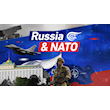Ukrainian fairy tales and the real situation on the ground
Western military supplies have become a logistical nightmare for Ukraine’s military command, and Kiev’s very approach to the use of Western weapons leads to their quick destruction.
-

A battery that consists of self-propelled guns manufactured by the US, France, or the USSR requires 2 or 3 times more components, 2 or 3 different types of ammunition
On the morning of July 21, the Russian media, citing sources in the security services, gleefully announced that the crews of HIMARS multiple rocket launchers, the most effective of all types of weapons received by Ukraine as part of Western assistance, were fully manned by Western instructors. There are two reasons for this – lack of trust in the Ukrainian military personnel and the low level of their training in the use of these missile systems. In fact, Western military supplies have become a logistical nightmare for Ukraine’s military command, and Kiev’s very approach to the use of Western weapons leads to their quick destruction.
For fairness' sake, by February 2022 the Armed Forces of Ukraine were indeed some of the best-equipped and trained armies in Europe. However, during the eight years of the country’s Euro-Atlantic integration, the Kiev authorities have not been able to re-equip their army, which, at the start of the conflict with Russia was armed with “Soviet-style” weapons. These are good and reliable weapons, built according to uniform standards since the time of the Warsaw Pact, and still produced in some Eastern European countries. But NATO weapons are much less standardized. In principle, only the calibers of small arms and artillery are the same, while the high-tech systems of German, French, and Belgian production are very different. They use different components, and mastering the use of each such system takes a lot of time. A battery that consists of self-propelled guns manufactured by the US, France, or the USSR requires 2 or 3 times more components, 2 or 3 different types of ammunition, and most importantly, their crews are not interchangeable. The same with tanks. That is why Poland, Slovakia, and Slovenia are sending their old T-72s and M-84 tanks to Ukraine in exchange for the latest models of German tanks from their Western partners. Their soldiers have enough time for retraining, but their Ukrainian colleagues don’t.
However, the stocks of Soviet-era arms in Europe are not endless and in conditions of war, weapons don’t last long. That’s why Kiev is demanding more and more supplies of Western equipment, without having enough trained crews to operate it. Meanwhile, retraining gunners and tankers takes between two and three months, which is a long time. Therefore, these crews usually die along with their weapons. Meanwhile, during the five months of the war, the Ukrainian army has faced a severe shortage of personnel. For two weeks now, the Russians have been demonstrating a number of captured elderly Ukrainian junior artillery and tank officers, who retired from the army back in the 1990s. They were given Polish tanks and sent to the front line. These POWs say that their units had been issued Western equipment that was completely unfamiliar to them, like British armored vehicles, which quickly broke down.
This is actually the reason for the supply of loads of obsolete armored fighting vehicles and armored personnel carriers to Ukraine. Such equipment is easier to master than high-tech artillery systems, and there are many such units sitting in decommissioned weapons depots. The problem is, however, that they get fixed right before being shipped. Ukrainian soldiers do not really trust them and the Russians either put them up for display or send them to the scrapyard, unwilling to use them. This being said, these units still allow new brigades to be equipped with motorized vehicles, at least formally. Besides, after the war Kiev will have to pay for them, so such supplies are quite profitable, which cannot be said about any truly sophisticated equipment.
Ukraine can mobilize 100,000, 200,000 and 300,000 people. Its defense minister spoke about the creation of a million-strong army. The question is, however, where Kiev is going to take specialists who can effectively use the latest Western weapons, which are now being sent to the frontlines piece by piece for propaganda purposes. Will NATO be able to train several thousand gunners each month, some of whom would have to learn to use German self-propelled guns in Germany, and French ones in France? Or maybe the Ukrainians will demand that the United States and the United Europe send in thousands of professional military personnel capable of using them?

 Slavisha Batko Milacic
Slavisha Batko Milacic
 4 Min Read
4 Min Read












